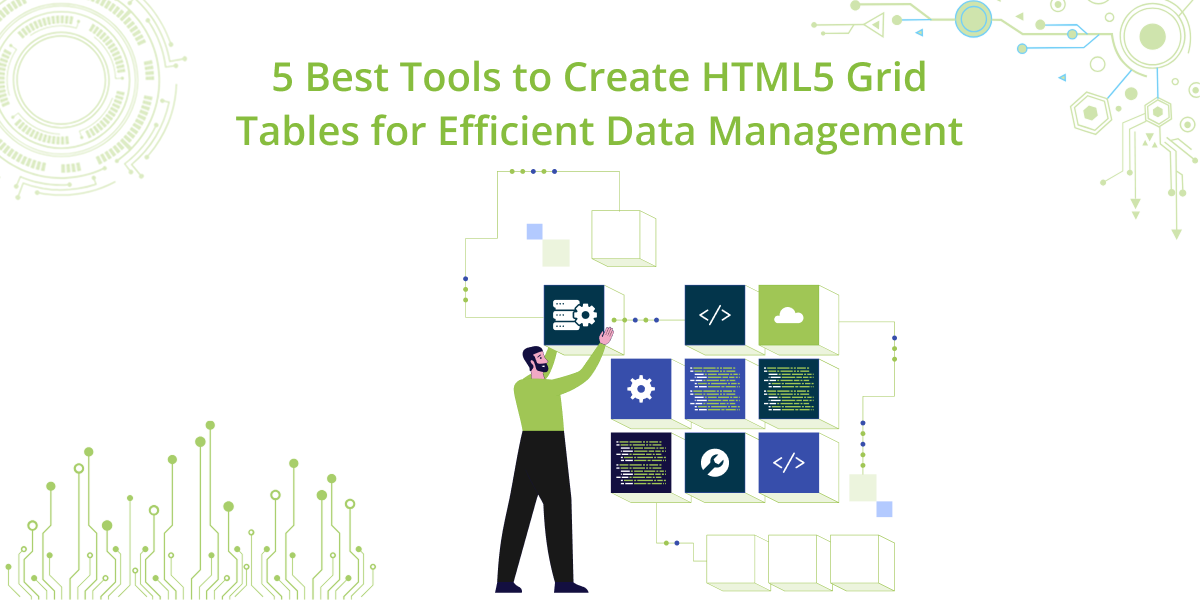5 Best Tools to Create HTML5 Grid Tables for Efficient Data Management
If you’ve worked on web development, you’ve probably had to display data in tables at some point. That’s where HTML5 and tables come in.
It’s a strong and reliable way for designing and showing structured data. Especially when paired with a good HTML grid layout or a CSS grid responsive setup. It can help in making the manual clean and readable on all types of devices.

There are some great tools out there for building data grids. From simple JavaScript grid libraries to more advanced React JS grid components, you’ve got options depending on what you’re building. These tools let users sort, filter, and even edit data directly in the grid—super easy for any modern web application development project.
Understanding how to use the HTML5 grid system and CSS grid template column settings also helps make your layout flexible. Choosing a well-built React component library can make things easier. The best React UI libraries give you pre-built components, so you’re not stuck coding every little thing from the ground up.
Honestly, with the right tools and a decent feel for layouts, building clean, responsive grids gets way easier, whether you’re setting up a dashboard, wrangling data, or working on a mobile app.
Why Sencha Ext JS Is The Best Solution For An HTML5 Grid Table?
Sencha Ext JS provides a grid that can handle millions of records without much effort. It’s built for speed and flexibility. Perfect when you need to work with large datasets and display them neatly using HTML5 and tables.
The Sencha Grid component brings a ton of features out of the box. You get all the basics like editing, filtering, grouping, and data locking. But it doesn’t stop there; it also supports drag-and-drop, drill-down views, real-time data updates, and customizable themes.
Whether you’re pulling data from local sources or over AJAX, RESTful APIs, or JSON, Sencha’s got you covered.
For developers working in React, the React JS grid component support makes it easy to plug Sencha into your projects. It pairs well with any React component library, especially if you’re using one of the best React UI library out there. You also get access to pre-built UI components that simplify your workflow.
Sencha’s grid system is built using CSS grid layout principles, offering responsive design and flexibility. It’s a strong fit for both web application development and mobile app development services, especially when you need fast, touch-friendly UI React components that look and feel right.
Main Features of Sencha
- It has the ability to handle a vast amount of data.
- It has advanced and flexible features that help in data management, like filtering, grouping, pagination, infinite scrolling, and live data streaming.
- It offers high customisation..
- You can export your data as CSV, HTML, Excel, or PDF, whatever works best for you.
- It runs smoothly on all major browsers and works just as well across web, mobile, and desktop platforms.
- Integration with popular React JavaScript library ecosystems, allowing for reusable UI components and smooth state management.
Sencha mainly comes with two pricing options called perpetual license and annual subscription. Both options have three editions called community, enterprise, and professional. You can clear any doubts about these packages by referring to their FAQ page or submitting an inquiry.
Why is W2UI Suitable To Create An HTML5 Grid Table?
W2UI is a smooth JavaScript grid and UI library built on top of jQuery. It leans on HTML5 and CSS3, making it a solid pick for front-end web development. Besides handling HTML5 and tables really well, it also comes with handy UI components like tabs, sidebars, pop-ups, forms, and layouts. All packed in one place.
It is designed with a well-defined separation between code logic and data. It makes the code clean and easy to manage. What stands out is how lightweight it is. At just 69KB when minified, it’s faster to load than most other JavaScript grid libraries, which makes it great for snappy web application development.
If you’re looking to build a responsive layout or need a JS grid that plays well in all modern browsers, W2UI has your back. It includes pre-built UI components and solid examples to help you build dynamic, CSS grid responsive dashboards with minimal code. Especially useful when teams are working with the React JavaScript library or mobile app development.
Main Features of w2ui
- It has well-equipped features like resizable columns, frozen columns, infinite scroll, reordering, and more.
- Lightweight library with a small footprint.
- The ability to create your own color schemes.
- Designed to work well with CSS grid layouts and supports CSS grid responsive behavior.
- A great fit for projects that need pre built UI components and an easy-to-use UI components library for efficient web application development.
How Successful Is jQuery Grid for Creating HTML Tables?
jQuery grid is a convenient tool if you’re running a web application that needs to show data in tabular form. It’s built on top of jQuery, which means it runs smoothly in most browsers and fits right into all kinds of web development setups.
You can do all the usual stuff with this JavaScript grid: edit, sort, filter, and flip through pages of data, right in the browser. It also uses AJAX, so data loads without any full-page refreshes.
It works well in web application development across different backends like PHP, Java, or even ColdFusion. Plus, adding different languages is simple, which makes it a great pick if you’re building something for a global audience.
It’s built on jQuery, so it runs fine in pretty much any browser. It fits into most web projects without much tweaking. Super easy when you’re juggling different tools or setups.
Main Features of jQuery Grid
- Runs fine on any browser or device, nothing quirky to deal with.
- Built-in themes are easy to adjust, so you can make them look how you want.
- It sticks to web standards, which just means your code stays clean and won’t break later.
- Paging through data is smooth, whether you’re handling it in the browser or on the backend.
- The JavaScript API’s are super straightforward. You’ll get the hang of it quickly.
- Suppose you need it in different languages. It’s easy, just drop in your own and you’re good.
- It works well with stuff like HTML5 grids and CSS grid columns, so your layout looks solid on any screen.
How Good Is Grid.js For Creating An HTML5 Grid Table?
Got a project where you need a flexible, interactive grid? Give Grid.js a look. It’s a free and open-source JavaScript library built with TypeScript. It makes creating modern HTML5 and tables feel way easier, no extra stress, no mess.
What makes Grid.js stand out is how easy it is to make it your own. Style it with regular CSS, drop it into a CSS grid, or build a full-on responsive layout. It runs great with plain JavaScript, but also gets along just fine with React, Vue, or even Angular. Whatever you’re using, it fits in pretty smoothly.
For React devs, Grid.js fits right in with your favourite React JavaScript library or React component library. You can combine it with pre-built UI components to build solid, reusable pieces for web application development or even mobile app development services.
What’s nice is that it takes care of the heavy lifting, things like sorting, filtering, searching, and pagination. So your grid stays quick and doesn’t lag, even when there’s a lot of data.
Whether you’re building dashboards, admin panels, or anything data-heavy, Grid.js helps you get started fast with a clean JS grid setup and gives you the flexibility to shape it your way.
Main Features of Grid.js
- You can get it up and running fast, and it’s super simple to use.
- The whole thing’s tiny, just 12KB even with all the extras.
- Need to tweak how it works? It’s easy to extend under the hood.
- It can handle data quickly, so your grids feel snappy and smooth.
- You can style it however you want using plain old CSS.
- If you are making mobile apps, it even supports React Native.
- It’s a great pick for grids that need to look good on any screen.
Can SlickGrid Be Used To Create Grid Tables?
SlickGrid’s a lightweight grid library built with jQuery, and it’s great when you need something fast and flexible for complex layouts.
One of its best features is that it loads data on the fly as you scroll, thanks to its smart dynamic loading engine. It doesn’t try to dump all your data at once. Just loads what you’re actually looking at, which keeps things running smoothly.
It plays well with external data sources, so you can hook it up to all sorts of frameworks and backends if you’re working on web application development and need something fast and responsive. If you’re dealing with a lot of data, SlickGrid’s definitely worth checking out.
You can move around with the keyboard pretty smoothly, which is great for usability. And the built-in UI pieces just make the whole thing feel easier to work with. In contrast, it’s not part of a React component library.
It pairs nicely with tools in a modern stack, especially if you’re mixing HTML grid layout or even CSS grid responsive elements elsewhere in your project.
Main Features of SlickGrid
- Virtual scrolling.
- Support for jQuery UI themes.
- Blazing fast data rendering.
- High customizability.
- Less configuration is needed compared to other grid libraries.
- Support for keyboard navigation.
- “Global Editor Lock” mechanism to handle concurrent edits of the same data.
- Works smoothly with CSS grid layout systems to maintain consistent design aesthetics.
Expanding Your Skills: Understanding Grids, Layouts, and Mobile-Friendly Designs
What are the Grid Layouts and How Do They Work?
You know when you need to line stuff up neatly on a page? That’s where grid layouts come in—they help you organise things into rows and columns. Some folks still use HTML5 tables, but these days, most lean toward the newer CSS grid layout. Grids help you build responsive, flexible designs.
Today, most developers lean on the HTML grid system and CSS grid responsive features to make sites look great on any device. You can control the layout with CSS grid template column settings. Even plug in a JS grid or a React JS grid component from a solid React component library for faster web development and web application development.
How to Create a Grid in JavaScript?
Ever needed to throw together a grid on the fly? If so, you’ve probably asked yourself how to pull it off using plain old JavaScript. The trick is using DOM manipulation to create rows and cells as needed. Here’s a simple example to get you started:
function createGrid(rows, cols) {
const container = document.getElementById('grid-container');
container.style.display = 'grid';
container.style.gridTemplateColumns = `repeat(${cols}, 1fr)`;
for (let i = 0; i < rows * cols; i++) {
const cell = document.createElement('div');
cell.classList.add('grid-cell');
container.appendChild(cell);
}
}
createGrid(16, 16); // Creates a 16x16 gridHere’s another common question: How do you make a 16x16 grid with JavaScript? This example shows how to set the grid display and adjust the template columns on the go. You can build flexible grids for anything, from games to data visualisations to clean UI layouts.
Latest Trends in HTML5 Grid Layouts
Here’s a quick rundown of what’s been trending lately with grids, the stuff that keeps your layout from falling apart:
- A lot of devs are now blending CSS Grid with Flexbox. It’s a solid combo when you need both structure and flexibility in one layout.
- People are getting better at making grids responsive, not just resizing stuff, but using media queries to tweak things exactly how they want.
- Subgrid has been getting more attention now that most browsers support it. It helps when you’ve got nested layouts and want them to line up cleanly.
- There’s more focus on accessibility, too. Grids aren’t just about looking good anymore; they’re being built to work smoothly with keyboards and screen readers.
- If you’re working with React, good news, most React UI libraries now come with pre-built grid stuff, so you’re not starting from scratch every time.
How Do I Improve the Performance of My HTML5 Data Grid?
To improve your HTML5 data grid performance:
- Use virtualisation techniques like those in SlickGrid to load only visible data.
- Minimise DOM updates by batching changes.
- Use efficient event handling and debouncing.
- Opt for lightweight grid libraries such as Grid.js or w2ui.
- Cache data and use fast rendering techniques.
- Implement lazy loading for remote data fetching.
- Use React JavaScript library frameworks optimised for UI performance.
Conclusion
If you’re building a web app, adding a clean and responsive HTML5 grid table can seriously level up how you show data. Tools like Sencha Ext JS offer powerful features, but if you want something lighter. Grid.js or w2ui work great too.
Knowing how HTML5 and tables work, plus how to use the HTML grid system and CSS grid layout, makes a big difference. Throw in a solid React JS grid component from your favourite React component library, and you’re set. With mobile-first design being key in web development and mobile app development services, responsive grid layouts are a must.
Get started with Sencha Ext JS today!
FAQs
Q: How to create a grid in JavaScript?
You basically throw a bunch of divs into a container, right? Then use gridTemplateColumns to lay out the columns, and just run a loop to fill in the grid cells. Super simple once you try it.
Q: How to create a 16x16 grid in JavaScript?
To create a grid loop, made 256 divs in a grid container, then set grid-template-columns to repeat(16, 1fr) to line them up evenly.
Q: How do I build a mobile app?
First, you pick what you’re building it for, like iOS or Android. Then grab something like Flutter or React Native, design how it looks, add the features, test it a bunch, and push it out there.
Q: How to create an app without coding?
To create an app without coding, you just need to use no-code tools like Bubble, Adalo, or Glide. They provide you with drag-and-drop stuff, set up things according to you, and launch your app without touching any code.
Q: How to create an app without programming?
App builders allow you to build an app without coding. It provides visual editors and pre-built templates. So you don't need to code from scratch.
Q: What is a cross-platform?
Cross-platform apps run on all devices. It means you write your code once, and it runs on whatever, iOS, Android, or web. You don’t have to build separate versions for each.
Q: What are the latest trends in HTML5 grid layouts?
Lately, people are blending Grid and Flexbox a lot, using media queries to make stuff responsive, trying out Subgrid for more control inside layouts, and pulling in React components to tie it all together.
Q: How do I improve the performance of my HTML5 data grid?
If your HTML5 data grid feels slow, start with virtualisation; it helps a lot with big data sets. Also, try to minimise DOM updates, since too many changes can drag performance down. Handle events smartly, cache whatever you can, and stick to lightweight tools like Grid.js to keep things fast and smooth.
Q: How can I make my HTML5 grid mobile-friendly?
Make grids mobile-friendly by using CSS Grid’s responsive features, applying media queries to adjust layouts, using touch-friendly UI components, and testing across

The Ext JS Data Grid is widely regarded as one of the most feature‑rich and…

The integration of LLMs into web applications has moved well beyond simple content generation and…

ReExt is a React library developed by Sencha that allows you to use Ext JS…









